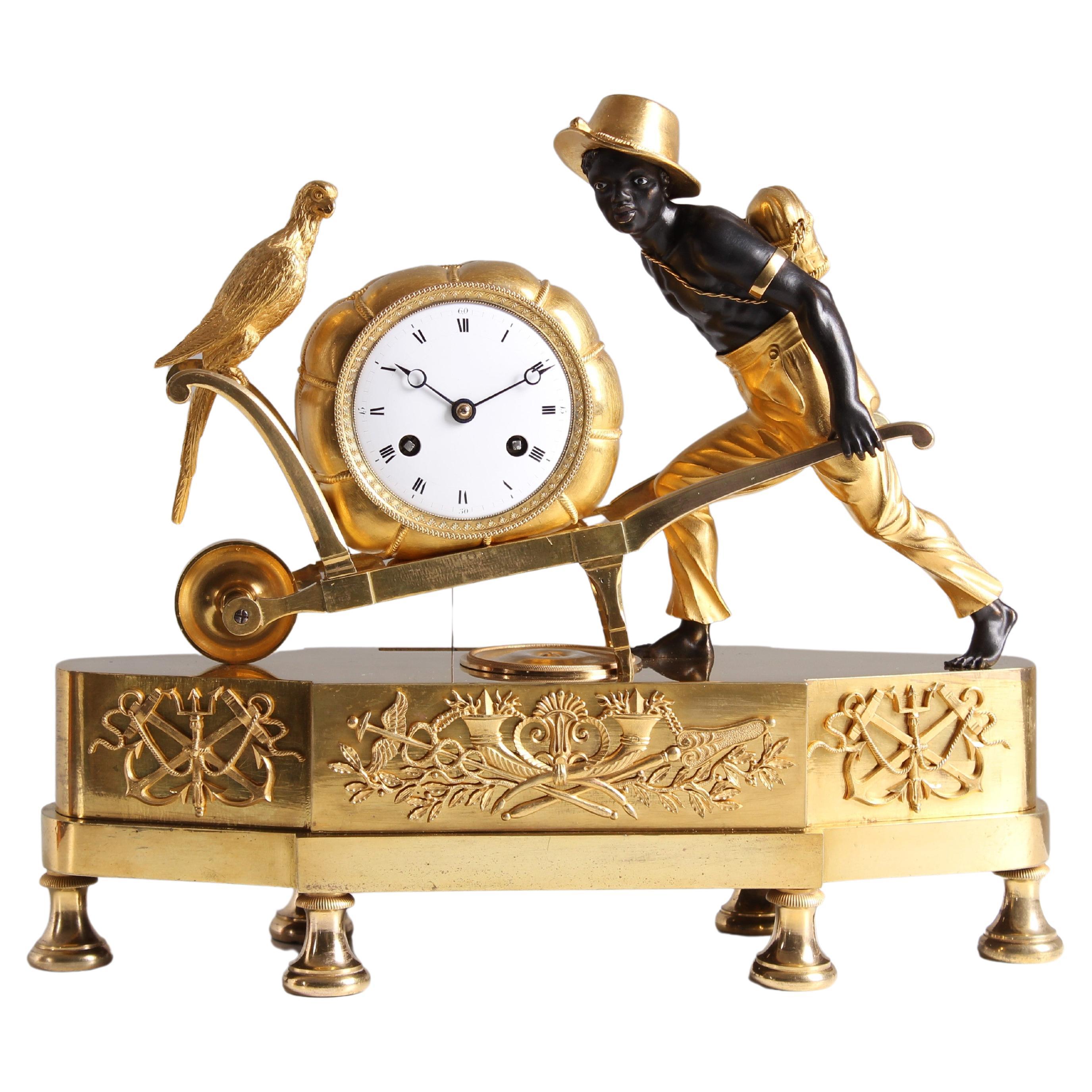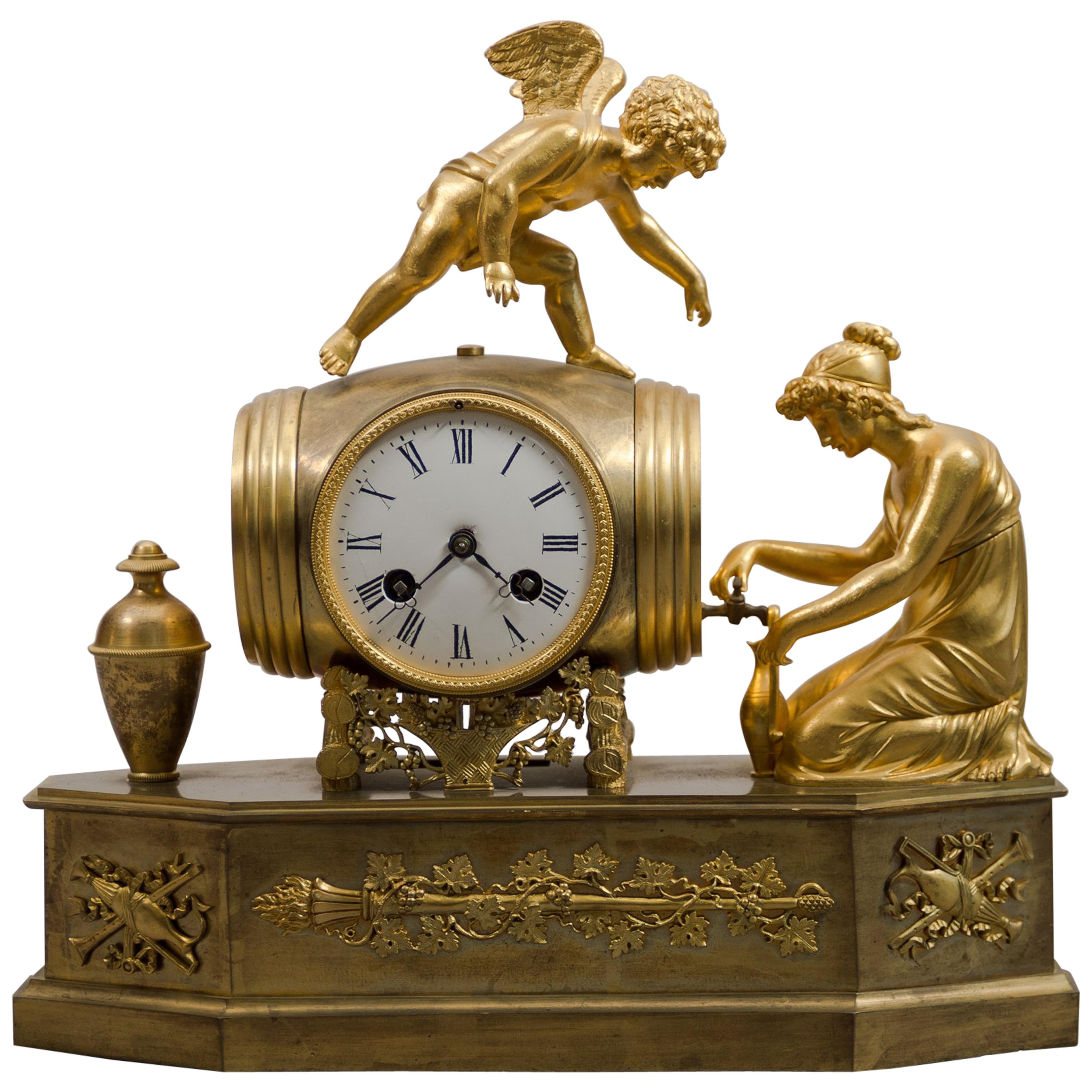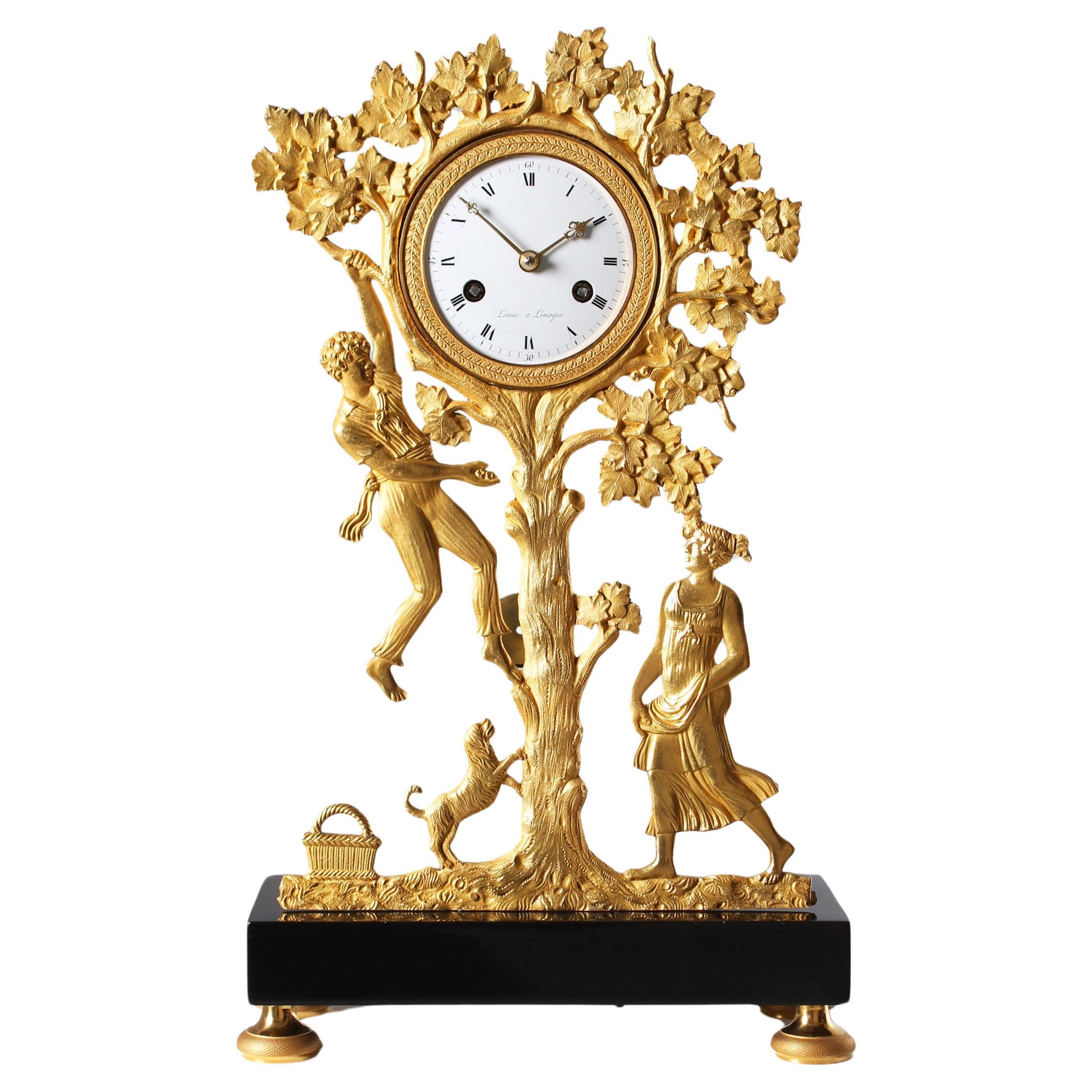Items Similar to Early 19th Century Ormolu Mantel Clock, Atala freeing Chactas, Paris, circa 1810
Want more images or videos?
Request additional images or videos from the seller
1 of 13
Early 19th Century Ormolu Mantel Clock, Atala freeing Chactas, Paris, circa 1810
About the Item
Mantel Clock "Atala and Chactas"
Paris
Bronze (fire-gilt and patinated), enamel
Empire around 1810
Dimensions: H x W x D: 40 x 32 x 11 cm
Description:
Very rare and extremely high quality French mantel clock, so-called Pendule Au Bon Sauvage.
Depicted are scenes from the love story "Atala or the love of two savages in the desert" written by Francois René Vicomte de Chateaubriand in 1801. At the beginning of the 19th century, this was probably the most famous love story in Europe, but today it has been forgotten.
The story, set in present-day Louisiana (USA), is roughly rewritten about the forbidden love between Chactas, a young Indian, and Atala, the beautiful daughter of a Spaniard.
Chactas is captured in a battle between two Indian tribes, chained to a palm tree and is to be sacrificed. Atala wants to save his life and convert him to Christianity. She unties him from the palm tree at night and they flee together into the wilderness of North America. Their love for each other grows stronger and stronger and they have prospects for a future together.
The story takes a tragic turn when Atala, who must remain a virgin due to a vow made by her mother, can no longer withstand the conflict of her feelings and commits suicide.
The main group of characters thus shows Chacta's liberation through Atala. Atala is leaning against a pile of logs. The animal fur thrown over the logs and the weapons leaning against the stack on the right give the impression of a night camp.
The bronze is of rarely beautiful quality, finely chiselled and makes the scene appear very lively. The contrast of fire-gilded and patinated bronze adds tension to the composition.
In the base we see the Entombment as the end of the tragic love story. This bronze work is also very detailed, the interplay of bright and matt gilding makes the flat relief appear much deeper than it is.
The depiction of the mantel clock presented here shows that the exotic was only known from stories and that the bronzier had his own ideas about the appearance of this distant world. The Indian, for example, has very European facial features and his skin was not black in reality, of course. The palm tree was also certainly not found in the North American wilderness.
The heart of the clock is a French pendulum movement, integrated into the wooden pile, with an eight-day power reserve and a lock plate striking a bell on the half and full hour. The pendulum is suspended on a thread, typical of the period. The classically shaped hands, so-called Breguet hands, are also typical of the time.
The enamelled dial has black Roman hour numerals, Arabic quarter hours and bears the signature: Le Roy hr. de Madame A PARIS.
Interesting facts:
The period from 1795 to about 1815 saw the creation of probably the most spectacular group of bronzes: The "Au bon Sauvage" pendulums - depictions of the "Noble Savage".
Today's viewers react to these objects with both fascination and irritation. Enthusiastic on the one hand about the obvious quality of the detailed bronzes and the allure of the exotic, on the other hand distanced and cautious because of the possible discrimination that is suspected behind them. The ambivalence of this feeling motivates the search for the conditions of origin of these pendulums.
Europeans found their new ideal of the natural man primarily in fictional and realistic travelogues about the Indians of North America, the black Africans and the South Sea Islanders. Some of these works are still considered world literature today, think of Jonathan Swift's "Gulliver's Travels" (1726) or Daniel Defoe's "Robinson Crusoe" (1719).
[Source: Elke Niehüser - The French Bronze Clock pp. 140-143]
Condition:
Beautiful and authentic and cleaned condition of the original fire gilding, so-called ormolu, with age-typical rubbing on the back of the clock. One of the feet is old-restored, was probably once broken off and has been reattached.
The movement is completely cleaned, overhauled and runs perfectly.
Recommended literature on this famous clock:
Elke Niehüser - The French Bronze Clock p. 144
Heuer / Maurice - European Pendulum Clocks p. 79 Fig. 140.
- Dimensions:Height: 15.75 in (40 cm)Width: 12.6 in (32 cm)Depth: 4.34 in (11 cm)
- Style:Empire (Of the Period)
- Materials and Techniques:
- Place of Origin:
- Period:
- Date of Manufacture:1810
- Condition:Repaired. Wear consistent with age and use. Authentic condition of the original fire gilding with age-typical rubbing on the back of the clock. One of the feet is restored, was probably once broken off and has been reattached. The movement is completely cleaned, overhauled and runs perfect.
- Seller Location:Greven, DE
- Reference Number:1stDibs: LU5419229715342
About the Seller
5.0
Platinum Seller
These expertly vetted sellers are 1stDibs' most experienced sellers and are rated highest by our customers.
Established in 2014
1stDibs seller since 2020
114 sales on 1stDibs
Typical response time: <1 hour
- ShippingRetrieving quote...Ships From: Münster, Germany
- Return PolicyA return for this item may be initiated within 14 days of delivery.
More From This SellerView All
- Early 19th Century Mantel Clock, Firegilt Bronze, Paris circa 1810Located in Greven, DEVery rare "Au Bon Sauvage" mantel clock France Fire-gilt and patinated bronze Empire around 1810 Dimensions: H x W x D: 34 x 41 x 13 cm Description: Extremely rare French bronze m...Category
Antique Early 19th Century French Empire Mantel Clocks
MaterialsBronze
- 19th Century French Ormolu Mantel Clock, circa 1840Located in Greven, DE19th Century French mantel clock France (Limoges) Ormolu around 1840 Dimensions: H x W x D: 37 x 22 x 10 cm Description: The bronze, cast in relief and then fire-gilded, stands on...Category
Antique 1830s French Charles X Mantel Clocks
MaterialsMarble, Bronze, Ormolu
- Empire Mantel Clock - La Bibliotheque, Ormolu, France, Paris, circa 1820By Le RoiLocated in Greven, DEMantel Clock - La Bibliotheque - In the study room Paris fire-gilt bronze, enamel Empire around 1820 Dimensions: H x W x D: 38 x 28 x 19 cm Description: Scenery mounted on an oval...Category
Antique Early 19th Century French Empire Mantel Clocks
MaterialsBronze
- 19th Century Mantel Clock "Astronomy", France circa 1830Located in Greven, DEAntique mantel clock on the theme of astronomy France Bronze Charles X around 1830 Dimensions: H x W x D: 48 x 19 x 10 cm Description: Unusual and beautifully crafted bronze mante...Category
Antique 19th Century French Charles X Table Clocks and Desk Clocks
MaterialsBronze
- 19th French Empire Mantel Clock, Pendule, Mercury, Gilded Bronze, circa 1815Located in Greven, DE19th century French pendule, mantel clock - Mercury the messenger of the gods France Bronze gilded Empire around 1815 Dimensions: H x W x D: 37 x 30 x 10 cm Description: French Empire...Category
Antique Early 19th Century French Empire Mantel Clocks
MaterialsBronze
- Early 19th Century Vase Pendule, Pendulum-Clock, Tardy à Lyon, Empire circa 1820Located in Greven, DEAntique vase clock France Fire gilded bronze Empire around 1820 Dimensions: H x W x D: 41 x 13 x 12 Description: Beautiful all gilt French mantel clock. The basic form is in the shape of an urn vase with lid...Category
Antique Early 19th Century French Empire Mantel Clocks
MaterialsBronze, Enamel
You May Also Like
- Ormolu Mantel Clock, Belgium, circa 1810-1820Located in Belmont, MAEmpire ormolu mantel clock, Belgium, circa 1810, Signed "J.B. Romaet a Gand". Decorated with a shepherd scene. Strikes the hour and half hour on a bell. With enamel clock face and si...Category
Antique 1810s Belgian Empire Mantel Clocks
MaterialsOrmolu
- 19th Century Empire Ormolu Mantel Clock, FidelityLocated in Paris, FREarly 19th century Empire clock crafted of gilt bronze, or ormolu, featuring an allegorical scene with a woman sitting at her work table play...Category
Antique Early 19th Century French Empire Mantel Clocks
MaterialsBronze
- Early 19th Century French Empire Ormolu Mantel Clock "Pouring Wine"Located in Los Angeles, CAA fine Early 19th century French Empire ormolu bronze mantel clock. Depicting a winged cherub standing atop a barrel while a kneeling lady pouring wine ...Category
Antique 19th Century French Empire Mantel Clocks
MaterialsBronze
- Early 19th Century Empire Ormolu-Mounted Bronze and Marble Mantel ClockBy Pierre-Victor LedureLocated in New York, NYA fine quality empire ormolu-mounted patinated bronze and rouge royale marble mantel clock. The patinated bronze figures depicting cupid and psyche. Attributed to Pierre-Victor Ledure...Category
Antique Early 19th Century French Empire Mantel Clocks
MaterialsMarble, Bronze, Ormolu
- French Ormolu Calendar Mantel Clock, 19th CenturyBy Aubert & KlaftenbergerLocated in Brighton, SussexA very good quality French, 19th century gilded ormolu mantel clock with a calendar dial. Having pink Sevres porcelain panels. Foliate and ribbon decoration, the clock being an eight...Category
Antique 19th Century French Louis XVI Mantel Clocks
MaterialsOrmolu
- French Ormolu Marble Mantel Clock, 19th CenturyLocated in Cypress, CASpectacular and unique French Napoleon III ormolu mounted white marble mantel clock, 19th century. The clock is surmounted by a gilt bronze pineapple finial with ribbons over a porcelain clock face with Roman Numerals enclosed into an ormolu egg...Category
Antique 19th Century French Louis XVI Mantel Clocks
MaterialsMarble, Bronze
Recently Viewed
View AllMore Ways To Browse
Early Converted
Old Paris Set
Over The Mantel
Antique Over Mantel
Set Of 19th Century Chains
New Ormolu
Early 19th Century French Clock
Paris Bronze Mantel Clocks
Full Mantel
Paris Ormolu Clock
Wooden Clocks
Wooden Clock
European Antique Clocks
American 1810
19th Mantel Clock Set
Ormolu European Bronzes
Antique De Paris Clock
Ormolu Clock Set





